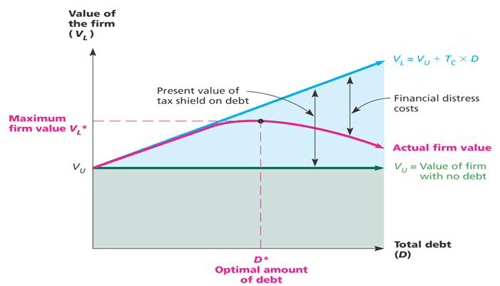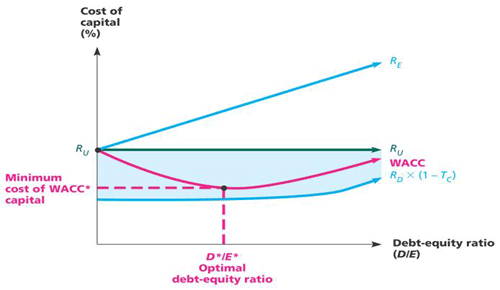- CFA Exams
- 2025 Level I
- Topic 3. Corporate Issuers
- Learning Module 6. Capital Structure
- Subject 4. Optimal Capital Structure
Seeing is believing!
Before you order, simply sign up for a free user account and in seconds you'll be experiencing the best in CFA exam preparation.
Subject 4. Optimal Capital Structure PDF Download
The optimal capital structure is the mix of debt, preferred stock and common equity that management tries to maintain to maximize the value of the firm. It must strike a balance between risk and return.
The gain from the tax shield on debt is offset by financial distress costs. As a firm continues to add more debt, financial distress costs start to rise slowly at first and then more rapidly, increasing the effective cost of debt and thus the WACC. Therefore, the WACC will first fall, then bottom out and finally start to rise. The conclusion is: in a world with taxes and financial distress costs, there is an optimal capital structure where the WACC is minimized and the share value of the stock is maximized.
The static trade-off theory suggests that the optimal capital structure is reached at the point where marginal distress costs exceed the marginal tax benefit from adding debt in the MM model.
The formula looks as follows:

An optimal capital structure exists that just balances the additional gain from leverage against the added financial distress costs.

The WACC falls initially because of the tax advantage of debt. Beyond the point D*/E*, it begins to rise because of financial distress costs.
At any point in time, management has a specific target capital structure in mind:
- If the debt ratio is below the target, expansion capital may be raised by issuing more debt.
- If the debt ratio is above the target, the firm may raise expansion capital by retaining earnings or issuing new equity.
Market Conditions
When considering to raise capitals, managers pay very close attention to the share price of the company's and market interest rates on its loans. Can their debt or equity issue be included in a benchmark index? What will the risk premium be for a new debt issue? Any significant impact on incremental costs of borrowing? Any macro-economic factors such as interest rates and inflation rates to consider?
Information Asymmetries and Signalling
Information can be used to change the cost of financing.
One of MM's assumptions is that investors and managers have the same information about the firm's prospects. This is called symmetric information. In reality, managers often have better information than outside investors. This is called asymmetric information. Managers often have better information than outside investors, and this has an important effect on the optimal capital structure.
One would expect a firm with very favorable prospects to try to avoid selling stock and, rather, to raise any required new capital by other means, including using debt beyond the normal target capital structure. Why? Assume that managers act in the best interest of shareholders.
- If the firm sells new stock, then as the firm expands successfully, the stock price will rise and the new stockholders will make a fortune.
- Had the company not sold more stocks, the current shareholders would have avoided sharing the success with new shareholders.
- So there is a motivation on the firm's part to avoid selling new stocks when it has exceptional prospects.
On the other hand, a firm with unfavorable prospects would want to sell stock which would mean bringing new investors to share the losses.
The pecking order hypothesis says that managers prefer the following ordering of financing:
- Retained earnings (avoid investor skepticism).
- Debt.
- Equity.
Therefore, a stock issue sets off a negative signal (the firm's prospects as seen by its management are not bright), while using debt is a positive, or at least a neutral, signal.
As a result, companies try to avoid having to issue stock by maintaining a reserve borrowing capacity, and this means using less debt in "normal" times than the MM trade-off theory would suggest. Why? If you don't have reserve borrowing capacity, and you have to issue new stocks for good projects, your stock price will be penalized: investors cannot see your good project (asymmetric information), and all they see is your negative signal - bad companies sell stocks.
Agency Costs
Equity agency problem is that managers might:
- use corporate funds for non-value maximizing purposes (perks, acquisitions, value-destroying growth), or;
- seek low risk due to undiversified interest in firm.
The agency cost of equity is the cost associated with monitoring a company's management by the company shareholders when the shareholders believe that the management is diverging from working towards obtaining shareholder's interests. The problem is most significant in large firms with diffuse stockholders where management ownership is low.
To mitigate this risk, shareholders can take actions such as requiring audited financial statements, holding an annual meeting, using noncompete employment contracts and insurance to guarantee performance.
User Contributed Comments 0
You need to log in first to add your comment.

I am using your study notes and I know of at least 5 other friends of mine who used it and passed the exam last Dec. Keep up your great work!

Barnes
My Own Flashcard
No flashcard found. Add a private flashcard for the subject.
Add